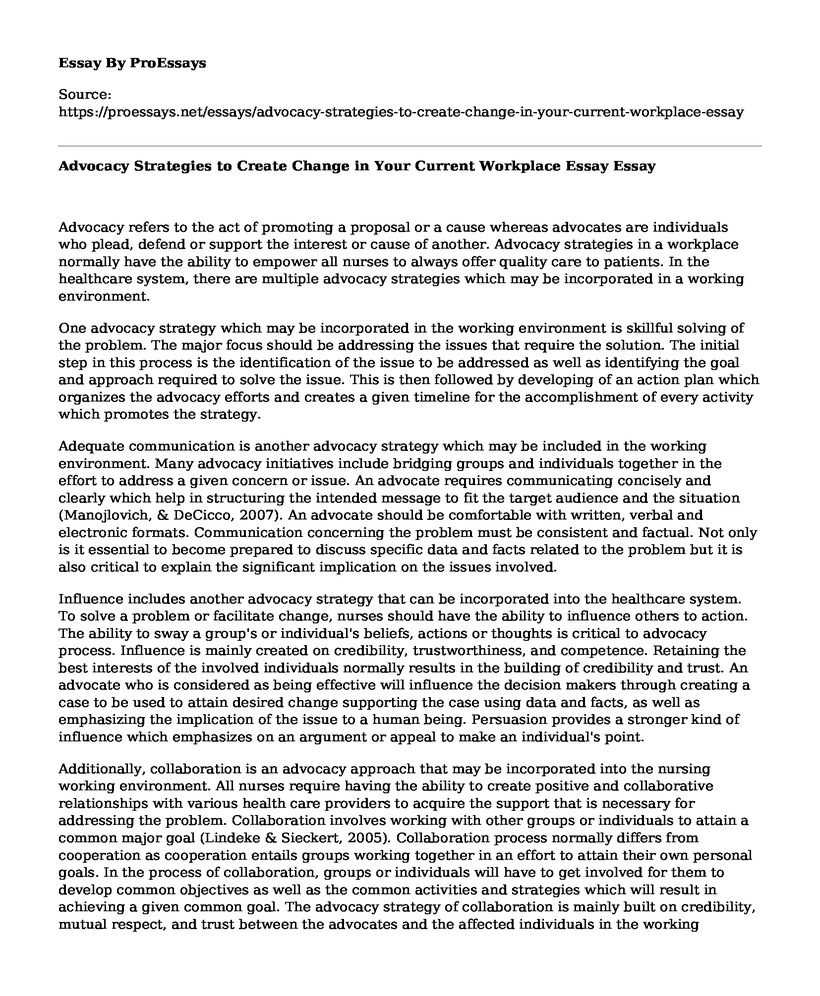Advocacy refers to the act of promoting a proposal or a cause whereas advocates are individuals who plead, defend or support the interest or cause of another. Advocacy strategies in a workplace normally have the ability to empower all nurses to always offer quality care to patients. In the healthcare system, there are multiple advocacy strategies which may be incorporated in a working environment.
One advocacy strategy which may be incorporated in the working environment is skillful solving of the problem. The major focus should be addressing the issues that require the solution. The initial step in this process is the identification of the issue to be addressed as well as identifying the goal and approach required to solve the issue. This is then followed by developing of an action plan which organizes the advocacy efforts and creates a given timeline for the accomplishment of every activity which promotes the strategy.
Adequate communication is another advocacy strategy which may be included in the working environment. Many advocacy initiatives include bridging groups and individuals together in the effort to address a given concern or issue. An advocate requires communicating concisely and clearly which help in structuring the intended message to fit the target audience and the situation (Manojlovich, & DeCicco, 2007). An advocate should be comfortable with written, verbal and electronic formats. Communication concerning the problem must be consistent and factual. Not only is it essential to become prepared to discuss specific data and facts related to the problem but it is also critical to explain the significant implication on the issues involved.
Influence includes another advocacy strategy that can be incorporated into the healthcare system. To solve a problem or facilitate change, nurses should have the ability to influence others to action. The ability to sway a group's or individual's beliefs, actions or thoughts is critical to advocacy process. Influence is mainly created on credibility, trustworthiness, and competence. Retaining the best interests of the involved individuals normally results in the building of credibility and trust. An advocate who is considered as being effective will influence the decision makers through creating a case to be used to attain desired change supporting the case using data and facts, as well as emphasizing the implication of the issue to a human being. Persuasion provides a stronger kind of influence which emphasizes on an argument or appeal to make an individual's point.
Additionally, collaboration is an advocacy approach that may be incorporated into the nursing working environment. All nurses require having the ability to create positive and collaborative relationships with various health care providers to acquire the support that is necessary for addressing the problem. Collaboration involves working with other groups or individuals to attain a common major goal (Lindeke & Sieckert, 2005). Collaboration process normally differs from cooperation as cooperation entails groups working together in an effort to attain their own personal goals. In the process of collaboration, groups or individuals will have to get involved for them to develop common objectives as well as the common activities and strategies which will result in achieving a given common goal. The advocacy strategy of collaboration is mainly built on credibility, mutual respect, and trust between the advocates and the affected individuals in the working environment.
Conclusion
To conclude, the advocacy strategies such as collaboration, influence, adequate communication and skillful solving of issues are complementary and mostly focus on promoting the nursing's voice and making sure that all nurses get included in the workplace decisions that affect patient care.
References
Lindeke, L. L., & Sieckert, A. M. (2005). Nurse-physician workplace collaboration. Online J Issues Nurs, 10(1), 5.
Manojlovich, M., & DeCicco, B. (2007). Healthy work environments, nurse-physician communication, and patients' outcomes. American Journal of Critical Care, 16(6), 536-543.
Cite this page
Advocacy Strategies to Create Change in Your Current Workplace Essay. (2022, Jul 06). Retrieved from https://proessays.net/essays/advocacy-strategies-to-create-change-in-your-current-workplace-essay
If you are the original author of this essay and no longer wish to have it published on the ProEssays website, please click below to request its removal:
- Evaluation Essay on Nightingale Community Hospital
- Paper Example on Attack on Azumer Water
- Essay Sample on Ethical Concerns on the Role of Business in Society
- Mr. Smith's Journey Through Aging and Memory Loss - Case Study
- Essay Example on Bowel Elimination Concerns: Constipation, Impaction, Diarrhea, & More
- Essay Example on Difference Between Quality Improvement & Quality Assurance
- Transformational Leadership: Relevance and Impact in Organizations - Paper Sample







